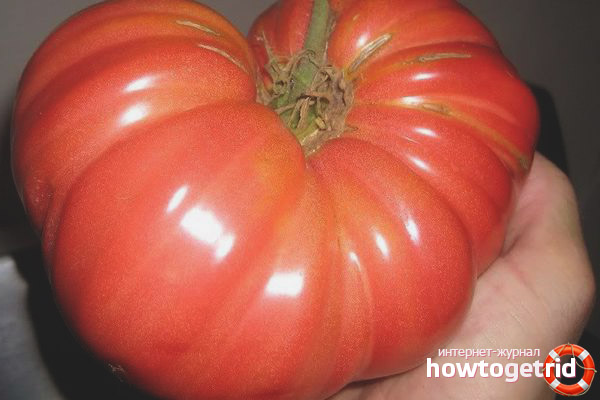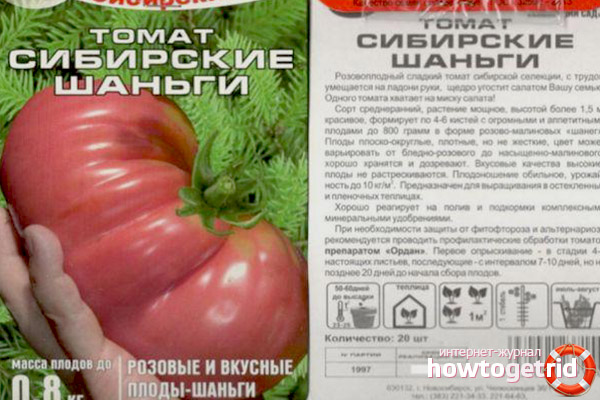The content of the article
This variety is more suitable for lovers of large and fleshy tomatoes. Fruits are considered universal in purpose. So, for example, these fruits can be used both in salads and for the preparation of tomato paste, juice, lecho and other preparations.
Characteristics
It can be grown both in greenhouses and in open ground. However, in the central strip, it is often recommended to grow in greenhouses. By maturity is considered mid-early. Fruit ripening begins 120 days after seed germination. According to the habit of the bush (growth characteristics) - indeterminate, the main stem can reach a height of 2 meters.
Each plant usually grows 5-6 brushes with fruits. Productivity is obtained up to 10 kg per square. m. The mass of the fetus can reach 800 grams, occasionally up to 1 kg, on average - 300 g. Therefore, one fruit is usually enough to make a salad. The pulp is fleshy, not watery, with an aroma. The taste is sweet with a pleasant aftertaste. Fruits are resistant to cracking.
Growing recommendations
When sowing seeds, it is recommended to close the seeds to a depth of 1.5-2 cm. After sowing, the seed container should be closed with a film or glass and put in a warm place, if possible with a temperature of about 26 degrees. After seed germination, it is best to keep the seedling container at a temperature of about 17 degrees.
After the formation of two true leaves, you need to seedlings (peck) seedlings in separate glasses. If the plants grow slowly, and their leaves are pale, then it is advisable to feed with a solution of nitrate or complex fertilizers, such as Fertika. The effect can also be obtained from top dressing with an extract from biohumus. A few days before planting, it is advisable to harden the seedlings. For this, it is advised to expose it for several hours under the open sky, for example, on a balcony.
Before planting seedlings, it is advised to introduce humus in a dose of 5-10 kg / sq. m. If humus is not enough, then humus can be added to the wells — either biohumus or WMD. Another option is to add humus with AVA fertilizer in a dose of 1/3 to 1/2 teaspoon in each well. It is better to plant seedlings in such a way that per square meter. m accounted for about 3 plants.
After landing care

It usually includes top dressing, plant formation and soil maintenance, that is, keeping the soil clean from weeds and at the same time loose and moist. This is most easily achieved by mulching grass or hay or peat. If you do not mulch, then you should water it about once a week and then loosen it slightly.
After the end of the May cold snap (for the non-chernozem zone) the plants need to be tied to the trellis. Before flowering the 3rd flower brush, you should try to do only potash-phosphorus fertilizers, for example, ash, potassium monophosphate. When this phase occurs, if necessary, it is possible to do top dressing with complex mineral (Zdraven, Mortar, etc.) or organic (Gumidar, Gumistar) fertilizers. The need for fertilizing depends on the initial level of soil fertility, the method of its maintenance, pre-planting or planting fertilizers.On relatively poor soils, for example, sandy in the non-chernozem zone, it may be necessary to fertilize with a solution of calcium nitrate and magnesium sulfate. Calcium nitrate should be added with vertex rot, and magnesium sulfate with inter-vein chlorosis of the lower leaves.
The formation of plants is reduced to the removal of stepsons, as well as leaves under the first flower brush.
Plant protection
Tomato plants, including Siberian shanga, can suffer from sunburn, diseases, pests. To prevent sunburn, it is advisable to harden plants, spray in the evening with a solution of Ecoberin. Diseases on tomatoes are infectious and physiological. The first can be divided into fungal, bacterial and viral. Fungal diseases include late blight, cladosporiosis, macrosporiosis. To bacterial - an infectious form of apical rot and black spotting, and to viral - mosaics. To protect against bacterial spotting, the biological product Gamair is suitable. It should also be used for prevention with the top of rot. For the same purpose, it is permissible to use the antibiotic Phytolavin.
Video: 9 secrets of a good tomato crop










Submit